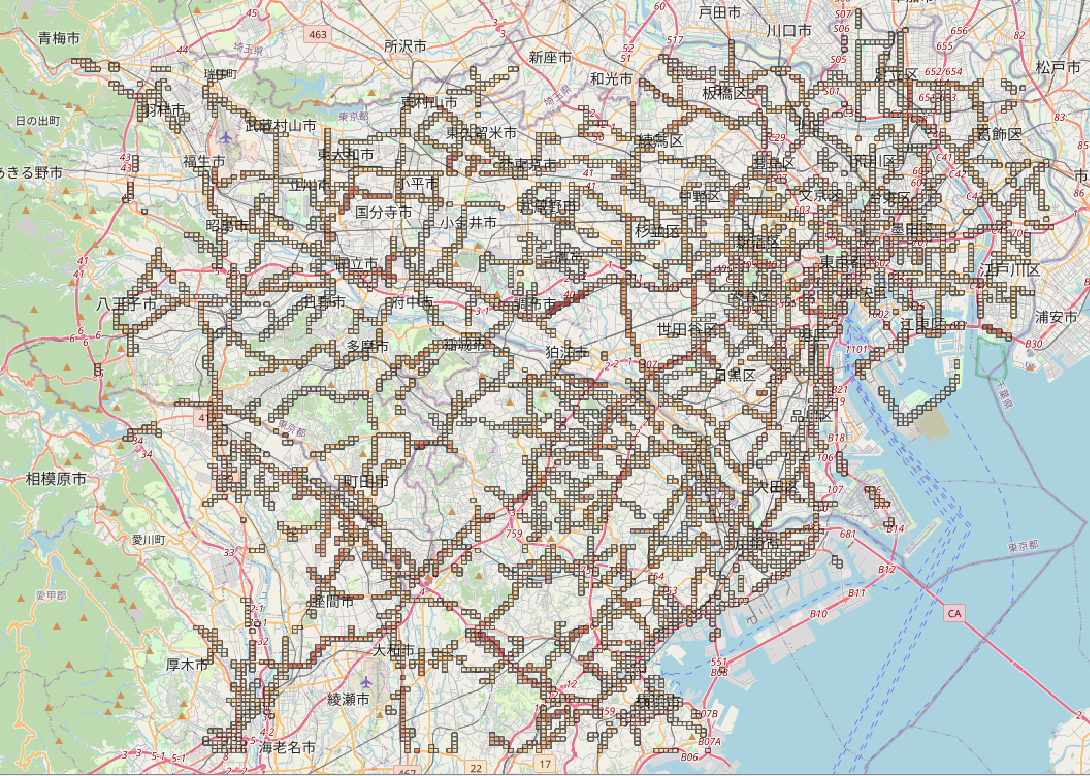 Mobile Environmental Risk Prediction
Mobile Environmental Risk Prediction
Overview
- Purpose
- Correlation Mining
- Prediction congestion and congestion risk during extreme weather events
- Applications
- Configuration
- Operating environment
- Precautions
- Reference
Purpose
Spatiotemporal correlation between environmental data (weather observation data, etc.) and traffic data (traffic flow and human flow data) and generate time-series map data that predicts the risk of traffic congestion and congestion caused by extreme weather events such as heavy rain and heavy snowfall. and traffic data (traffic flow and human flow data).
Correlation Mining
In order to discover spatiotemporal correlation patterns between environmental and traffic data, frequent patterns are discovered based on data mining methods such as FP-growth. In addition, the Spatially High-Utility Itemset Mining (SHUIM[1]) method can rapidly extract patterns of high local utility (e.g., congestion concentrations). can be extracted at high speed.
Prediction congestion and congestion risk during extreme weather events
Based on the correlation patterns discovered from weather data such as precipitation and traffic flow data in a regional mesh (250m square), the system predicts the risk of traffic congestion (10-scale value based on traffic jam length) from weather forecast data. Based on the correlations between weather data such as precipitation and traffic flow data, the system predicts congestion risk (10-scale value based on congestion length) from weather forecast data. Similarly, weather and human flow data can be used to forecast congestion risk (10-scale values) can also be forecasted.

Applications
- Develop an application that searches for and navigates risk-avoiding routes in response to forecasts of traffic congestion and congestion risk during extreme weather events. Develop applications that search and navigate routes to avoid risk according to forecasts of traffic congestion risk and traffic congestion risk in extreme weather conditions, etc.

Configuration
This information asset consists of.
- Processing program (Python language)
- Transaction generator program
- Frequent Pattern Mining (FPGrowth) Program
- risk map generator program
- Frequent Set Extraction (SHUIM) Program
- Data model
- Primary mesh area table (analysis format)
- Secondary mesh area table (analysis format)
- Tertiary mesh regional tables (analysis format)
- Quadratic mesh regional tables (analysis format)
- 5th mesh area table (analysis format)
- Precipitation data table (event format)
- Transaction table (public format)
- Prediction model
- correlation rule set
Operating environment
We confirmed the operation in the following environment.
- OS : Ubuntu 18.04 LTS
- RAM : 8GB Recommended
- DISK SPACE : 500GB or more
- Internet connection available
- Python : 3.x(Does not work with 2.x)
- PostgreSQL : 9.2 or more
When using the xDataEdge[2]environment, the following conditions are required in addition to the above.
- Services such as Apache, Nginx, etc. that have HTTP server functions (LISTEN to HTTP/HTTPS ports) must not be running on the OS.
- Have root privileges on the OS where xData Edge is installed
Precautions
- Restrictions
- Functional Limitations
- This information asset is not guaranteed to operate in environments other than those shown in the operating environment.
- Data Restrictions
- Users must prepare their own traffic data.
- Functional Limitations
- Disclaimer
- While every effort has been made to ensure that the information on this page is as accurate as possible, we do not guarantee its accuracy or safety.
- We are not responsible for any damages caused by the contents of this page or by what is provided.
- All information provided on this page is sample only and we are not responsible for any predicted results.
Reference
- [1]Kiran, R. U., Zettsu, K., Toyoda, M. Kitsuregawa, M., Philippe F. V., Reddy, P. K.: Discovering Spatial High Utility Itemsets in Spatiotemporal Databases, 31st International Conference on Scientific and Statistical Database Management (SSDBM 2019), Santa Cruz, CA, USA, pp.49-61 (July, 2019).
- [2]xData Edge manual:https://www.xdata.nict.jp/docs/guide/xdata-edge/overview/